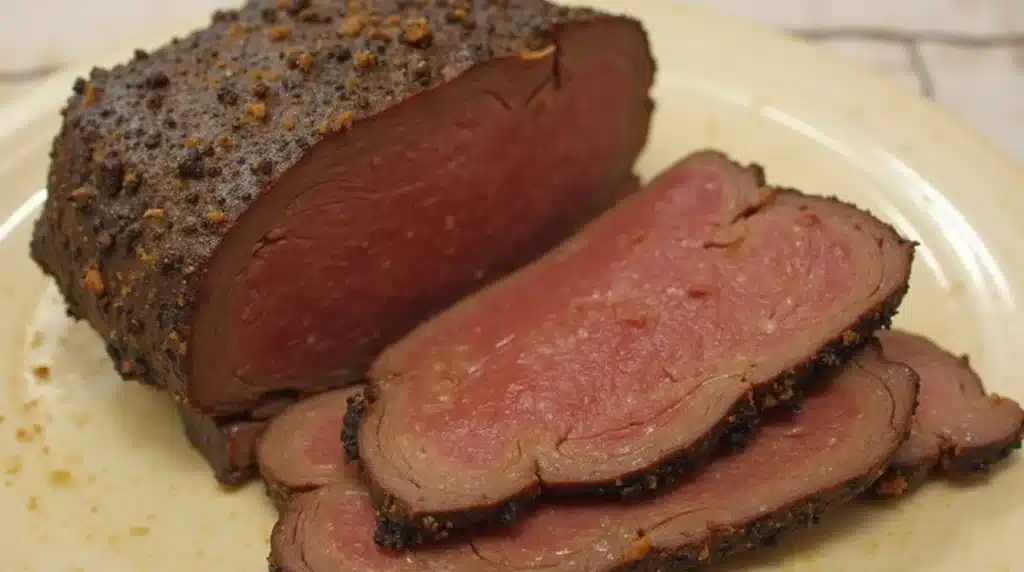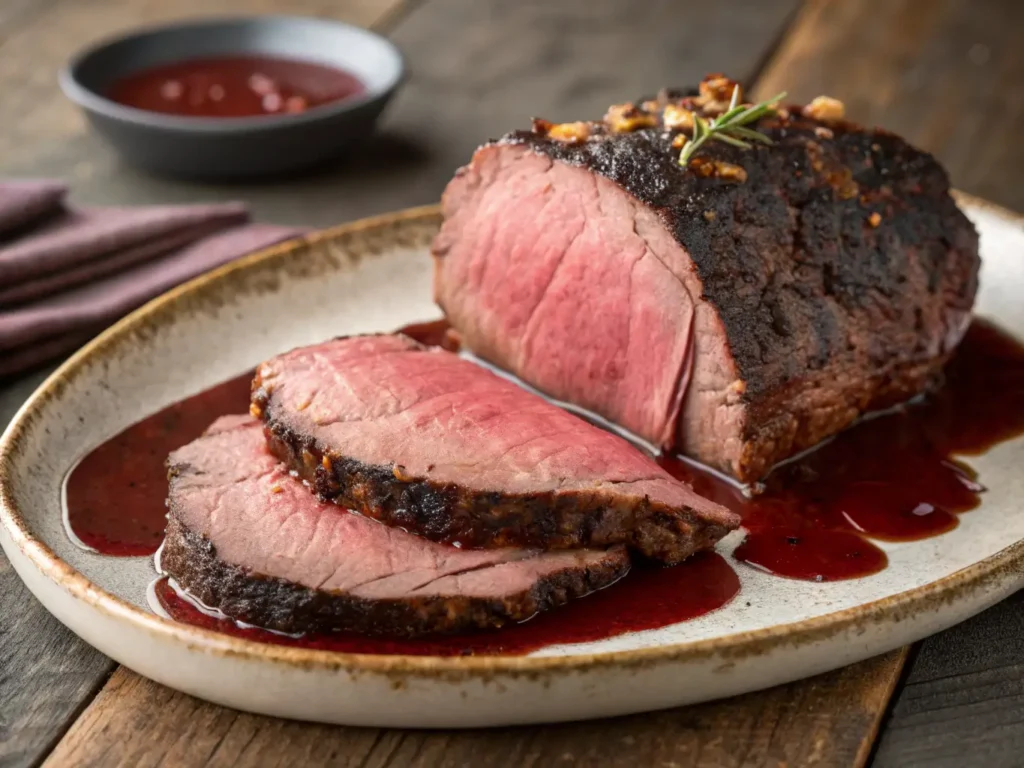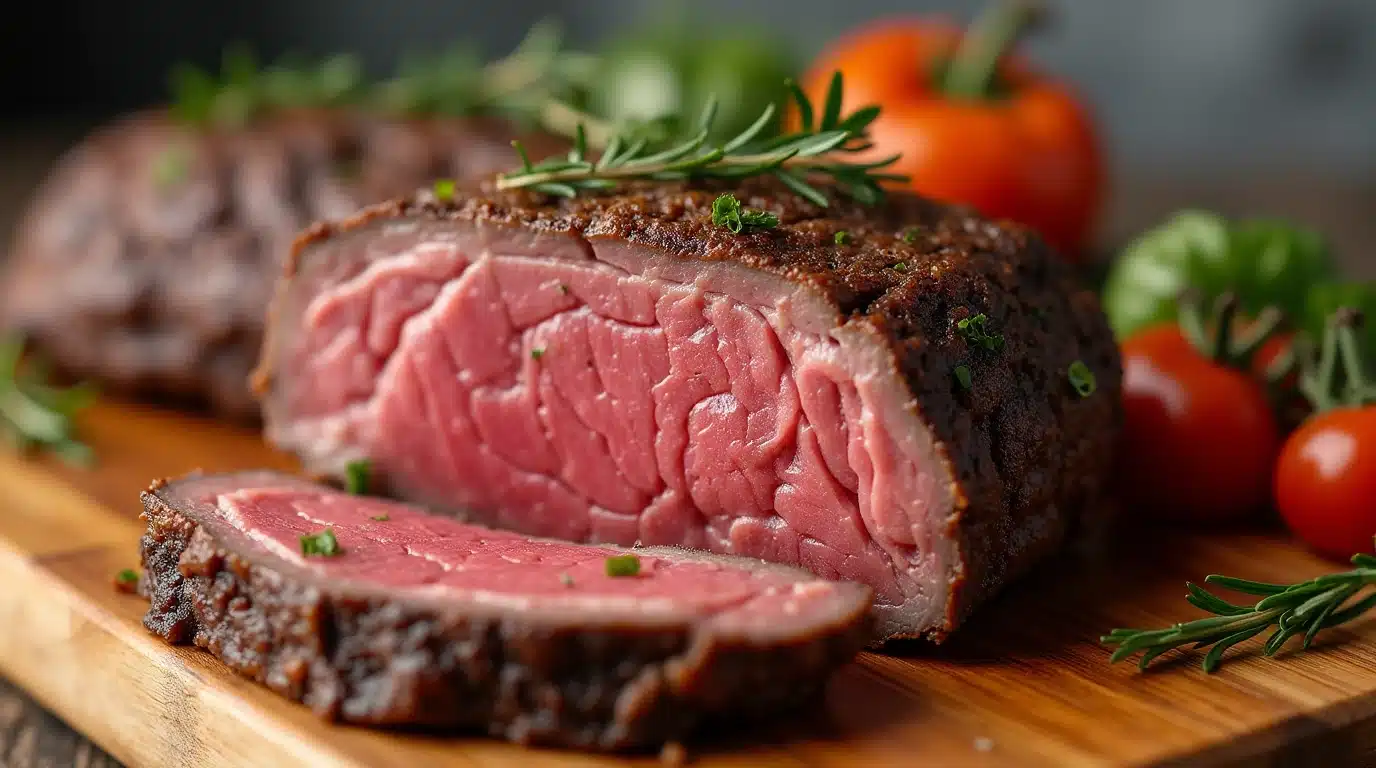This article provides a complete guide to cooking beef bottom round roast. It includes cooking methods, tips, and more.
Understanding the Beef Bottom Round Roast
The beef bottom round roast is a lean cut of beef. It comes from the rear leg of the cow. This area is quite muscular. Therefore, the meat tends to be tough. However, with the right cooking techniques, it becomes tender and flavorful. Consequently, many cooks choose this cut.
PrintBeef Bottom Round Roast: A Complete Guide
- Total Time: 1 hr 30 min
- Yield: 6 servings 1x
Description
A classic beef bottom round roast that’s oven-roasted to tender perfection with a flavorful herb crust ideal for Sunday dinners, meal prep, or slicing into sandwiches.
Ingredients
- 3–4 lb beef bottom round roast
- 2 tbsp olive oil
- 4 cloves garlic, minced
- 1 tbsp fresh rosemary or 1 tsp dried
- 1 tbsp fresh thyme or 1 tsp dried
- 1 tsp onion powder
- 1 tsp salt
- 1/2 tsp black pepper
- 1/2 tsp paprika
- 1 cup beef broth
- Optional: 1 tbsp Worcestershire sauce
Instructions
- 1. Preheat oven to 450°F (230°C).
- 2. In a small bowl, mix olive oil, garlic, rosemary, thyme, onion powder, salt, pepper, and paprika.
- 3. Pat roast dry with paper towels and rub the herb mixture all over the meat.
- 4. Place roast on a rack in a roasting pan. Add beef broth and Worcestershire sauce to the bottom of the pan.
- 5. Roast at 450°F for 15 minutes to sear, then reduce heat to 325°F (165°C).
- 6. Continue roasting for 60–75 minutes, or until internal temperature reaches 130–135°F for medium-rare.
- 7. Remove from oven, tent loosely with foil, and let rest for 15–20 minutes before slicing thinly against the grain.
- 8. Serve with pan juices or your favorite sauce.
Notes
- Use a meat thermometer for accuracy bottom round is best served medium-rare to medium.
- Letting the roast rest is key to juicy slices.
- Great for leftovers in sandwiches, wraps, or stir-fries.
- Prep Time: 15 min
- Cook Time: 1 hr 15 min
- Category: Main Dish
- Method: Roasting
- Cuisine: American
Nutrition
- Serving Size: 6 oz
- Calories: 310
- Sugar: 0g
- Sodium: 400mg
- Fat: 17g
- Saturated Fat: 6g
- Unsaturated Fat: 10g
- Trans Fat: 0g
- Carbohydrates: 1g
- Fiber: 0g
- Protein: 36g
- Cholesterol: 90mg
Keywords: bottom round roast, beef roast, oven roast, herb crusted roast
What is Beef Bottom Round Roast?
Specifically, beef bottom round roast comes from the outer part of the thigh. It’s a large, oval-shaped cut. It lacks the marbling found in other cuts like ribeye. As a result, it’s more affordable. Furthermore, it’s known for its lean texture. Consequently, many people find it appealing. It’s often sold as a roast. However, it can also be sliced into steaks.
- Location: Outer part of the cow’s thigh.
- Shape: Large, oval-shaped.
- Texture: Lean and relatively tough.
- Marbling: Low levels of intramuscular fat.
- Cost: Generally more affordable than other roasts.
Characteristics of a Beef Bottom Round Roast
The main characteristic of beef bottom round roast is its lean nature. It has very little fat marbling. Therefore, it can be dry if not cooked correctly. Additionally, it has a robust beef flavor. However, this is less intense than other cuts. Consequently, it’s often paired with flavorful sauces. Also, it’s best cooked low and slow. This helps tenderize the meat.
- Lean: Low in fat content.
- Flavor: Robust beef flavor.
- Texture: Can be tough if not cooked properly.
- Tenderness: Requires slow cooking for best results.
- Color: Dark red.
Why Choose a Beef Bottom Round Roast?
There are several reasons to choose beef bottom round roast. Firstly, it’s more budget-friendly. Secondly, it’s a versatile cut. You can roast it, braise it, or use it for pot roast. Furthermore, it’s a good source of lean protein. Therefore, it’s a healthy option if cooked right. Lastly, its flavor improves significantly with proper cooking methods.
- Cost-Effective: More affordable than other cuts.
- Versatile: Suitable for various cooking methods.
- Lean Protein: Good source of protein.
- Flavor: Develops rich flavor when cooked correctly.
- Family Favorite: Can feed a crowd easily.

Preparing Your Beef Bottom Round Roast
Proper preparation of your beef bottom round roast is crucial. This will ensure a delicious result. Accordingly, let’s look at some essential steps. These steps enhance both flavor and texture.
Trimming and Tying the Roast
First, trim excess fat from the roast. This helps create a better sear. It also prevents excess greasiness. Then, if needed, tie the roast with kitchen twine. This ensures even cooking. Furthermore, tying helps the roast retain its shape. Beef bottom round roast benefits from these steps.
- Trim Excess Fat: Reduces grease and improves sear.
- Tie with Twine: Ensures even cooking.
- Shape Retention: Helps the roast keep its form.
- Even Cooking: Promotes uniform temperature distribution.
- Neat Presentation: Creates a more appealing roast.
Seasoning Your Beef Bottom Round Roast
Seasoning is essential for any roast. The beef bottom round roast, particularly, benefits from a good seasoning. Use salt, pepper, and other herbs. This enhances the beef flavor. Furthermore, you can also marinate the roast. Marinating adds moisture and flavor. Consequently, it makes for a much tastier meal.
- Salt and Pepper: Basic seasoning for flavor enhancement.
- Herbs: Thyme, rosemary, and garlic work well.
- Marinades: Add moisture and flavor.
- Even Coating: Ensure the seasonings cover the entire roast.
- Flavor Infusion: Allows flavors to penetrate the meat.
Searing the Beef Bottom Round Roast
Searing the beef bottom round roast before roasting is highly recommended. This step creates a flavorful crust. The crust seals in the juices. Also, it adds depth to the flavor profile. Use a hot pan and some oil. Sear all sides of the roast. This is a very important step.
- Hot Pan: Use a hot pan for a good sear.
- Oil or Fat: Prevents sticking and helps with searing.
- All Sides: Sear each side to create a crust.
- Flavor Development: Enhances the taste of the roast.
- Juice Retention: Seals in the meat’s natural juices.
Cooking Methods for Beef Bottom Round Roast

There are several ways to cook a beef bottom round roast. Each method gives a unique result. Thus, choose a method based on your preferences. Understanding each method helps.
Roasting a Beef Bottom Round Roast
Roasting is a popular method for cooking a beef bottom round roast. It’s a simple way to get delicious results. Preheat your oven. Place the seared roast in a roasting pan. Then, cook at a low temperature. This ensures the meat becomes tender. Also, you must use a meat thermometer.
- Preheat Oven: Ensure the oven is properly heated.
- Roasting Pan: Use a pan suitable for roasting.
- Low Temperature: Helps tenderize the meat.
- Meat Thermometer: Monitor internal temperature.
- Resting Period: Allow the roast to rest after cooking.
Slow Cooking a Beef Bottom Round Roast
Slow cooking is another great method. It’s perfect for tough cuts like the beef bottom round roast. Slow cooking breaks down the connective tissues. This method results in a tender and juicy roast. Use a slow cooker or a Dutch oven. Cook at a low heat for many hours.
- Slow Cooker or Dutch Oven: Ideal for slow cooking.
- Low Heat: Cook at low heat for best results.
- Long Cooking Time: Several hours for maximum tenderness.
- Tender Results: Breaks down tough connective tissues.
- Juicy Roast: Retains moisture during slow cooking.
Braising a Beef Bottom Round Roast
Braising is a great method. Specifically, it’s perfect for tenderizing. This involves browning the roast. Then, you cook it in liquid. The liquid can be broth or wine. The braising process results in a tender, flavorful roast. It also makes a delicious sauce.
- Browning: Sear the roast before braising.
- Liquid: Use broth, wine, or other flavorful liquids.
- Low Simmer: Simmer the roast in the liquid.
- Flavorful Sauce: The braising liquid becomes a sauce.
- Tender Results: The meat becomes very tender.
Tips for Cooking a Perfect Beef Bottom Round Roast
Cooking the beef bottom round roast properly requires attention to detail. Follow these tips to achieve the best results. It will improve your overall culinary process.

Monitoring Internal Temperature
Monitoring the internal temperature is very important. Use a meat thermometer to ensure the beef bottom round roast reaches the correct temperature. This is essential for both safety and taste. The ideal temperature depends on your desired level of doneness. Therefore, use a reliable meat thermometer.
- Meat Thermometer: Essential for accurate readings.
- Doneness Levels: Different temperatures for different preferences.
- Safety: Ensures the meat is cooked to a safe temperature.
- Consistent Results: Helps achieve consistent doneness.
- Avoid Overcooking: Prevents dry and tough meat.
Resting the Roast
Resting after cooking is a crucial step. It allows the juices to redistribute throughout the meat. Therefore, this results in a more tender and flavorful roast. Let the roast rest for about 10-15 minutes. This significantly improves the overall quality.
- Juice Redistribution: Allows juices to settle in the meat.
- Enhanced Flavor: Results in a more flavorful roast.
- Tenderness: Makes the roast more tender.
- Resting Time: Allow at least 10-15 minutes.
- Avoid Slicing Immediately: Wait for the resting period to end.
Slicing Against the Grain
Slicing against the grain is crucial. This breaks down the muscle fibers. As a result, the slices are more tender and easier to chew. Always identify the direction of the muscle fibers. This will help you slice properly. Then, use a sharp knife to make the cuts.
- Muscle Fibers: Identify the direction of the fibers.
- Sharp Knife: Use a sharp knife for clean slices.
- Tender Slices: Breaks down muscle fibers for tenderness.
- Easier Chewing: Makes the roast easier to eat.
- Proper Presentation: Results in more appealing slices.
Flavoring Your Beef Bottom Round Roast
Adding flavor to a beef bottom round roast is crucial. The right flavors can elevate this cut of meat. Accordingly, let’s explore ways to enhance taste.
Using Herbs and Spices
Herbs and spices add layers of flavor. Use fresh or dried herbs. Good options include thyme, rosemary, and garlic. Additionally, spices like paprika and black pepper provide warmth. Therefore, mix these to enhance the taste of your beef bottom round roast. Experiment with different blends.
- Fresh Herbs: Thyme, rosemary, and sage.
- Dried Herbs: Provide a concentrated flavor.
- Spices: Paprika, black pepper, and garlic powder.
- Flavorful Rubs: Create a unique blend of flavors.
- Even Coating: Ensure the spices cover the entire roast.
Creating Flavorful Sauces and Gravies
A delicious sauce or gravy can complement a beef bottom round roast perfectly. Make a classic beef gravy from the pan drippings. Additionally, try a red wine reduction. You can also make a mushroom sauce. The sauces add moisture and complexity to the dish.
- Pan Drippings: Use for a rich and flavorful gravy.
- Red Wine Reduction: Adds depth and complexity.
- Mushroom Sauce: A classic pairing with beef.
- Herbed Sauces: Enhance with fresh herbs.
- Moisture and Flavor: Sauces add both moisture and taste.
Marinating Your Beef Bottom Round Roast
Marinating the beef bottom round roast can infuse it with flavor. It also tenderizes the meat. Use a marinade with acidic ingredients. These break down the muscle fibers. Good options are vinegar, lemon juice, or wine. Marinate for several hours or overnight. This method enhances tenderness.
- Acidic Ingredients: Vinegar, lemon juice, or wine.
- Flavor Infusion: Adds unique flavors to the meat.
- Tenderizing: Breaks down muscle fibers for tenderness.
- Extended Marination: Marinate for several hours or overnight.
- Better Flavor: Improves both taste and texture.
Serving Your Beef Bottom Round Roast
Serving your beef bottom round roast is just as important as cooking it. Pair it with the right sides. Present it in an appealing manner. It enhances the overall meal experience.
Pairing with Side Dishes
Serve with compatible side dishes. Mashed potatoes are a classic choice. Roasted vegetables like carrots and potatoes are great, too. Consider serving it with a fresh salad. These sides complement the rich flavors of the beef. Therefore, it creates a balanced meal.
- Mashed Potatoes: A classic pairing.
- Roasted Vegetables: Carrots, potatoes, and onions.
- Salads: Add a fresh and crisp element.
- Grain Dishes: Rice or quinoa are good options.
- Balanced Meal: A variety of sides create a balanced meal.
Slicing and Presentation
Slicing and presentation affect the appeal of the dish. Slice against the grain. Arrange the slices on a platter. Drizzle with pan juices or sauce. Garnish with fresh herbs for a more appealing look. Thus, it enhances the visual appeal.
- Against the Grain: Slice against the grain for tenderness.
- Platter Arrangement: Arrange slices attractively.
- Pan Juices or Sauce: Drizzle over the slices.
- Fresh Herbs: Garnish with herbs for visual appeal.
- Appealing Presentation: Makes the meal more enjoyable.
Using Leftovers
Leftovers from your beef bottom round roast can be used in many ways. Slice the leftover roast and use it for sandwiches. Shred the meat and use it in tacos or soups. Leftovers can also be used to make hash. This reduces food waste.
- Sandwiches: Use sliced roast beef for sandwiches.
- Tacos or Burritos: Shredded beef is perfect.
- Soups or Stews: Add shredded beef for flavor.
- Beef Hash: A classic way to use leftovers.
- Reduce Food Waste: Leftovers provide convenient meals.
Addressing Common Concerns About Beef Bottom Round Roast
There are several common concerns regarding beef bottom round roast. Addressing these helps you better understand this cut. Therefore, you can make informed cooking choices.

Tenderness Issues
One main concern is the tenderness. Because it’s a lean cut, it can be tough. However, slow cooking and braising break down the connective tissues. Proper preparation makes the meat much more tender. Therefore, use the right cooking methods.
- Lean Cut: Can be tough if not cooked right.
- Slow Cooking: Breaks down connective tissues.
- Braising: Makes the meat more tender.
- Marinating: Can tenderize the meat.
- Proper Cooking Techniques: Essential for tenderness.
Dryness Problems
Dryness can also be an issue with beef bottom round roast. Since it lacks fat, it can dry out easily. Searing the roast before cooking seals in the juices. Additionally, using a marinade helps retain moisture. Therefore, avoid overcooking the roast. Keep an eye on internal temperature.
- Low Fat Content: Can lead to dryness.
- Searing: Seals in the meat’s juices.
- Marinating: Helps retain moisture.
- Avoid Overcooking: Can dry out the meat.
- Monitor Internal Temperature: Ensures correct doneness.
Flavor Challenges
Beef bottom round roast has a mild beef flavor. However, proper seasoning and sauces enhance the taste. Use a flavorful marinade or herb rub. Consider braising with wine or broth. This enhances the flavor profile. Therefore, you can create flavorful results.
- Mild Flavor: Can be enhanced with seasoning.
- Marinades and Rubs: Add flavor and moisture.
- Braising Liquid: Adds complexity to the flavor.
- Sauces and Gravies: Complement the roast with additional flavors.
- Layering Flavors: Combine different flavor elements.
Check out our Grond Beef and Rice Pie for another easy dessert favorite from the same era.
Frequently Asked Questions (FAQs)
Beef bottom round roast slow cooker?
Yes, is great for slow cooking. Slow cooking breaks down the tough muscle fibers. This method results in a very tender roast. Cook it on low for several hours. Add broth and vegetables for extra flavor.
What is beef bottom roast good for?
Beef bottom roast is good for slow cooking, braising, and pot roast. It’s a lean cut that becomes tender with slow, moist heat. It’s also great for slicing for sandwiches. The leftover meat is perfect for tacos or soups.
Does a bottom round roast get more tender the longer you cook it?
Yes, a bottom round roast does get more tender the longer you cook it, especially with slow cooking methods like braising. The low, slow cooking breaks down the tough connective tissues. This process results in a more tender roast. Therefore, the longer cooking time improves the texture.
What is the best way to tenderize a bottom round roast?
The best ways to tenderize a bottom round roast are slow cooking and braising. Marinating with acidic ingredients also helps. These methods break down the muscle fibers. This results in a more tender roast. Use a meat thermometer and don’t overcook it.
Is chuck roast and bottom round roast the same?
No, chuck roast and bottom round roast are not the same. Chuck roast comes from the shoulder area and has more marbling. Bottom round roast comes from the rear leg and is leaner. They require different cooking methods to achieve the best results.
Conclusion
In conclusion, beef bottom round roast is a versatile and budget-friendly cut. It is ideal for slow cooking, braising, and roasting. Proper preparation and cooking techniques are essential. These steps ensure a tender, flavorful roast. With the right approach, beef bottom round roast can be a delicious and economical choice. Ultimately, you can achieve impressive results.

